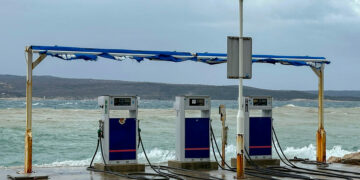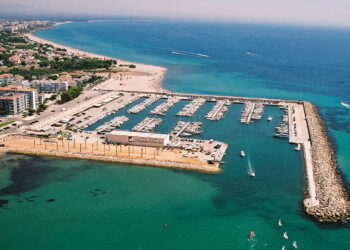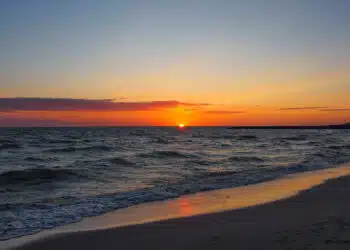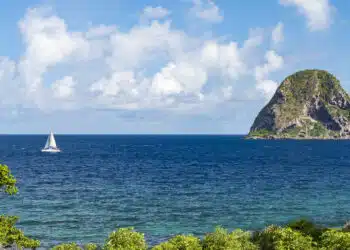Those traveling by charter boat in Dalmatia should spend at least one day for Hvar einplanen. The old town on the Adriatic island of the same name in Split-Dalmatia County is considered by many to be one of the most beautiful towns anywhere. The “Croatian St. Tropez” has an eventful history. A good insight into its history is provided by the Španjola fortress, which towers over the harbor and whose construction was begun as early as 1282 under Venetian rule. Before the prize comes the sweat, however, but the stair climb is worth it! – Tip from the SeaHelp editors.
We leave Vis with our charter sailing yacht right after breakfast in the direction of the northeastern Pacleni Otoci, because our destination for today is called Hvar. The picturesque old town and harbor, which from time immemorial has been in the sphere of interest of various powers, lie directly behind the “Hell Islands” in a northeasterly direction. Already from the first pre-Christian millennium there is evidence of an Illyrian settlement in Hvar. In the fourth century B.C. Syracuse Greeks founded a settlement at the same place.
From 1278 to 1797 Hvar was under Venetian rule and during that time it became an important Adriatic port. The town experienced a cultural blossom and received its present form at that time. From 1797 onwards, the island and the town came under the rule of the House of Habsburg. The Napoleonic Wars followed, after which the island was again annexed to the Empire of Austria and the Austro-Hungarian Empire. After the First World War, Hvar was briefly under Italian rule, after which (1921 to 1941) the island belonged to the Kingdom of Yugoslavia. Since the end of World War II it was part of Yugoslavia, and since 1991 Hvar has been part of the Republic of Croatia.
Sailing beat from Vis to Hvar: Lunchtime off Otok Marinkovac with fresh mussels
After beautiful sailing weather we reach Otok Marinkovac and drop anchor in the sheltered bay diagonally opposite the (high-priced) Antonio Patak restaurant – lunchtime! We had bought four kilos of fresh mussels at the Pescarija Kalambera in the harbor the morning before we left Vis, and now we are preparing them in a delicate white wine sauce and with lots of garlic in the aft cockpit. This is accompanied by bread and Dalmatian wine – delicious! We calculate: the entire meal cost us for seven people a total of about 50 euros, including the wine – at Antonio across the bay we would have paid the same price – but per person.
The weather had clouded over in the meantime, and when we moored at the edge of the harbor of Hvar (it is advisable to reserve a berth in advance with the harbormaster), it began to rain. The temperature has instantly dropped a few degrees, and the wind has picked up some strength. However, we are spared from the dreaded bora, which is also called bura here.
Mooring at the town harbor of Hvar: our neighbor is a superyacht!
Right next to us is the 43-meter MY BINA, a superyacht (ex KIMBERLY II) built by Mondo Marine in 2006 and completely refitted in 2015, which can also be chartered in the high season for a measly 175,000 euros per week – though our 14-meter-long and 7.87-meter-wide flybridge Lagoon 450 F from Dream Yacht Charter, with its four double and two crew single cabins and lavishly sized saloon, already seemed pretty big to us!
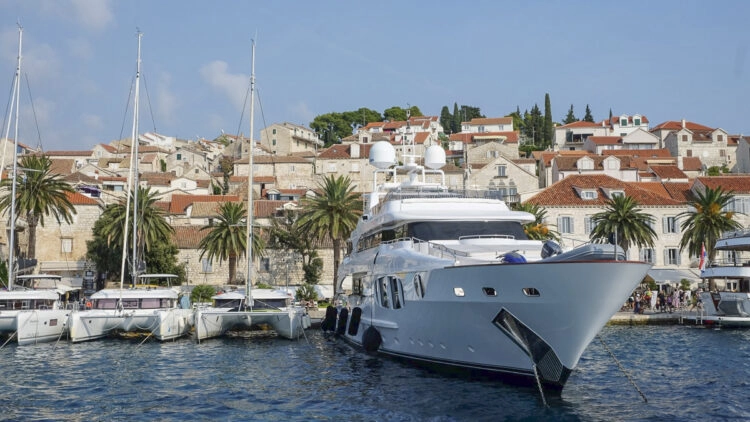
From the east side of the harbor at the promenade Obala Riva with its cafes and restaurants, it is only a few steps to Hvar Square. We take advantage of the slightly cooler temperatures and, starting at the Fairy Gate (Porta di Datallo), climbing the stairs, explore the old and beautiful part of Hvar, where there are palaces and residential and commercial buildings from the 15th and 16th centuries. Once at the top, we continue up small serpentines surrounded by shrubs to the Hvar Fortress Fortica or, as the locals just call it, the Španjola.
Ascent to the Hvar Fortress Fortica or, as the locals call it, the Španjola
Built the fortress towering over the city at the beginning of the 16th century (1551) during the reign of Venice. However, the construction of the fortress began much earlier, in 1282, and the funds for its construction came from revenues from the salt trade. The massive complex probably owes its name Španjola (Spanish Fortress) to the fact that in the 14th century Spanish army engineers were also involved in its construction.
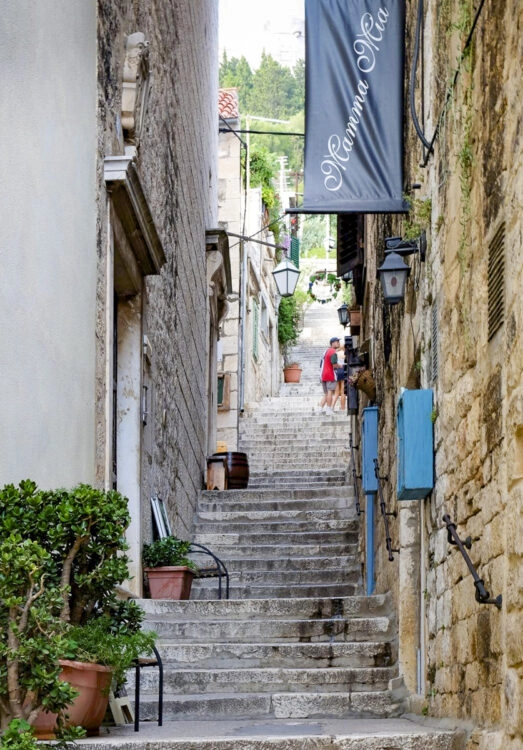
Originally there were four round towers, buildings for storing gunpowder, cisterns, a prison and a small chapel dedicated to John the Baptist in the fortress. When the Turks attacked, looted and pillaged the town in 1571, almost all Hvar citizens managed to take refuge in the fortress and escape. But their luck did not last long: only eight years later, on October 1, 1579, lightning struck the very building where the gunpowder was kept. An explosion was the result – and severe damage to the fortress and the city.
Until the second half of the 19th century, the complex was renovated piece by piece. Under Austrian rule, the fortress served as barracks. When the town of Hvar finally lost its military importance, the Španjola was abandoned and fell into disrepair. It was not until 1971 that measures were again taken to preserve it.
Reward of climbing the stairs: great views of old Hvar, the harbor and the Hell Islands
Whether the climb to Španjola is worth it, everyone must decide for themselves – in any case, we really enjoyed being able to finally move around a bit after a few days on board. And finally, the architecture of the partly centuries-old houses and villas along the alleys to the left and right of the stairs is impressive, and the panoramic view of the town of Hvar, its surroundings, the harbor and the Pacleni Islands from the fortress is just great.
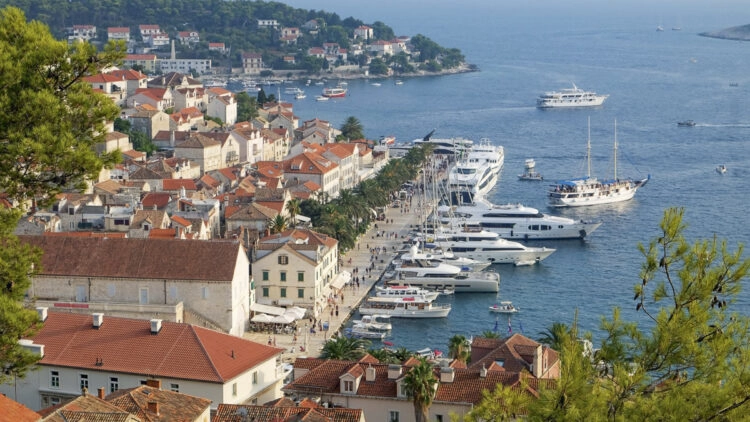
On the way down, following the countless steps now leading down, we reach the restaurant Luna, hidden in a side alley, where, sitting on the upper floor, virtually in the open air, we can choose between a meat and a fish menu with three courses. For our next visit to Hvar, we decide instead to visit Konoba Menego, located a little further up the stone steps, whose menu reads great.
We end the evening in the Pjaca bar just in front on the Hvar square with Pina Coladas and a good shot of Zacapa. In front of the bar a musician plays sad tunes – and reminds us that our beautiful cruise will soon come to an end. We set off before the thunderstorm approaching from the north; above the fortress, daylight flashes illuminate the black night sky for seconds. Just in time before the rain we lie in our bunks, having secured the boat with extra lines and fenders. Hatches battened down – and good night!







